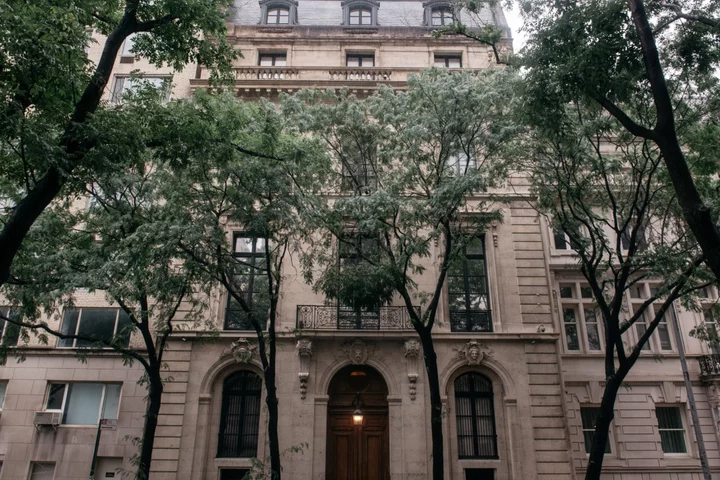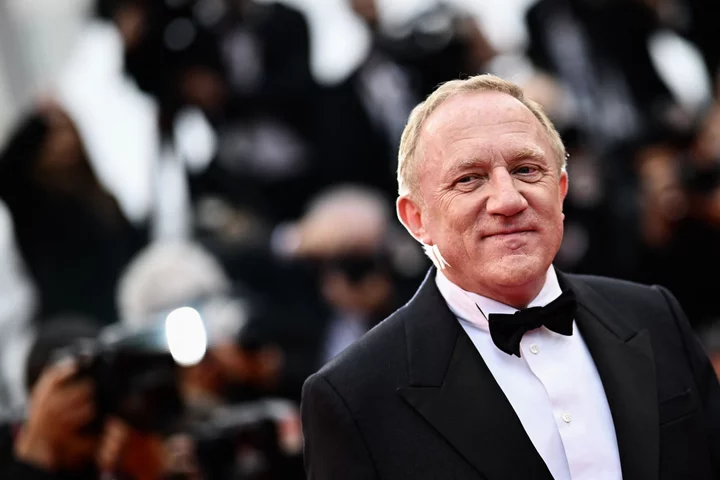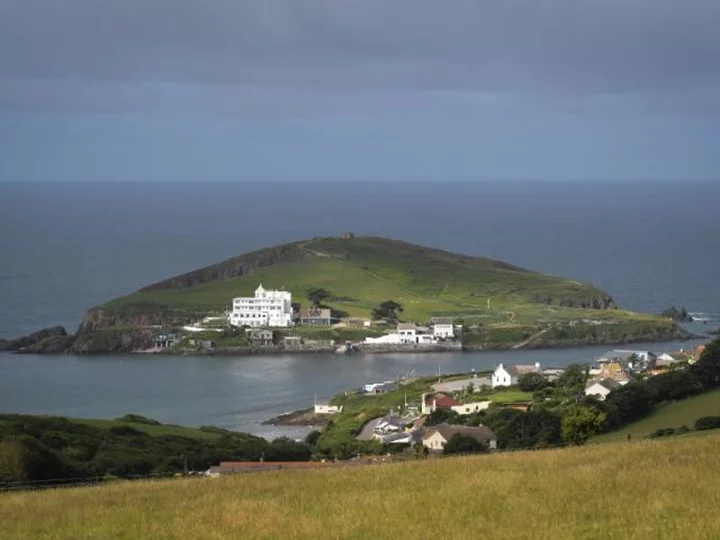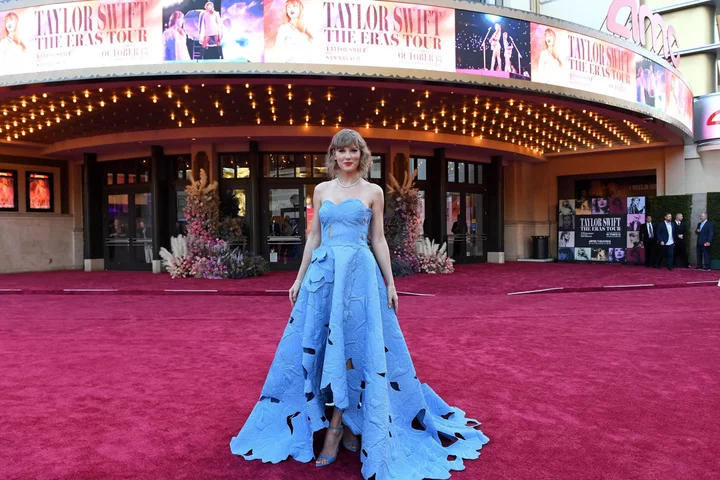Sitting on his yacht in January 2011, Jes Staley was taking time out from running one of the world’s largest investment banks to enjoy the fruits of his success.
“Anchored in Chrismas [sic] Cove,” Staley wrote in an email to Jeffrey Epstein from his 91-foot yacht moored in the US Virgin Islands. “Heaven is being on Bequia. Safe travels to Paris. And, as always, thanks for the friendship.”
That month marked a high point for the relationship between the two men. In the space of a few weeks, Epstein provided Staley with use of his private Caribbean island, offered to introduce him to one of the world’s richest men and, for good measure, eased the path of his eldest daughter into a graduate program at an elite US university.
The friendship was a good investment for the convicted pedophile financier. Days before Staley sailed to Epstein’s island, Epstein had managed to avoid being dumped as a client by Staley’s employer, JPMorgan Chase & Co., even though the firm’s private banking boss wanted him gone. At one point that year, Staley asked the bank’s top lawyer, Stephen Cutler, to reconsider his recommendation that Epstein be kicked out, according to two people familiar with what Cutler said in a recent deposition and who asked not to be identified discussing statements that haven’t been made public.
Twelve years on, and four years after Epstein’s death in prison by suicide, the details of how Staley and Epstein formed a mutually beneficial bond are only now becoming clear as the former Barclays Plc chief executive officer faces a lawsuit by JPMorgan, as well as a British regulatory probe.
“Any association with Epstein was a mistake and in hindsight we regret it, but we did not help him commit his heinous crimes,” a spokeswoman for JPMorgan said in an emailed statement. “We would never have continued to do business with him if we believed he was engaged in an ongoing sex-trafficking operation.” As for Staley, the spokeswoman said, “Jes is accused of unspeakable acts and, if true, should be held accountable.” Kathleen Harris, a lawyer for Staley in London, declined to comment.
The following account is based on a review of thousands of pages of documents and emails that have surfaced in recent months in connection with lawsuits involving JPMorgan, a public records request and interviews with people with knowledge of the events.
The relationship between Staley and Epstein, which dates to the early 2000s, went beyond that of banker and client. The two formed a deep friendship that Staley in one email to Epstein called “profound.”
Epstein, who had been a JPMorgan private banking client since 1998, helped Staley land a stake in a $7 billion hedge fund, Highbridge Capital Management, in 2004. The deal fueled Staley’s ascent at JPMorgan and demonstrated how Epstein, who had connections to wealthy businessmen, could help make things happen to the banker’s advantage.
Writing in November 2009 from Epstein’s New Mexico ranch, where Staley was relaxing in a hot tub with a glass of white wine, the JPMorgan investment banker expressed his gratitude: “This is an amazing place. Truly amazing. Next time, we’re here together. I owe you much. And I deeply appreciate our friendship. I have few so profound.”
Staley’s visit came as Epstein was under home confinement as a result of his conviction a year earlier for procuring prostitution from a minor, a crime Epstein would later compare in a newspaper interview to a person who “steals a bagel.”
The trip to the ranch was one of at least four made by Staley over the years to Epstein’s luxury getaways. On April 12, 2015, months before he would be tapped as Barclays CEO, Staley sailed to Epstein’s home on Little St. James in the US Virgin Islands. On his yacht with him were his wife, Debora, and two daughters, according to a person with knowledge of the trip who requested anonymity discussing private information.
Such was the closeness of the Staley family to Epstein that shortly before the visit Staley had emailed Epstein to say one of his daughters, Alexa, “wants to sit with you and talk about her future.”
Alexa Staley, who was finishing her Ph.D. in physics at the time, could thank Epstein for help getting into New York’s Columbia University. In November 2010, her father had fretted in an email to Epstein about her chances of gaining a place in the program. “She is not giving Columbia her non physics GRE’s,” Staley wrote, before listing her scores.
“She can sit with Richard Axel when I get back, he won the Nobel prize.. he has guaranteed me,” Epstein, replied, referencing the name of an eminent biologist and Columbia professor.
Two months later, Alexa Staley received an email from Cookie Neil, director of science development at Columbia. “Spoke with Jim today,” Neil wrote, “and he mentioned that the GRE score is what it is — not to worry — the score does not seem to be a problem according to my sources.”
Alexa forwarded the email to her father, writing “Huh?” Staley forwarded the message on to Epstein with a smiley face emoticon.
Ben Chang, a spokesman for Columbia, said there is “no factual basis to the claims that Epstein influenced the admissions process. From our review, the student in question was highly qualified and excelled in our program.” Alexa Staley declined to comment, her father’s lawyer said, as did Axel. It could not be determined from the emails who the Jim that Neil said she spoke to was. Neil, who is no longer at Columbia, didn’t respond to a message sent via LinkedIn.
In January 2011, not long after the email flurry and just before Staley sailed to Epstein’s Caribbean hideaway, Epstein was ordered to register as a high-risk sex offender in New York. “What a paradise,” Staley wrote in a Jan. 22, 2011, email that was among the documents JPMorgan turned over in connection with a lawsuit brought against the bank by the US Virgin Islands. “When I retire, I’m going to put a mooring in front of your dock for my boat. Amazing place.”
The lawsuit, which alleges JPMorgan knowingly benefited from Epstein’s sex trafficking, is scheduled for trial in October. The bank has accused the US Virgin Islands government of deflecting from its own culpability by allowing Epstein to live in the territory with $300 million in tax breaks.
As Staley was relaxing on the island, Epstein was helping him schedule a meeting at the upcoming World Economic Forum in Davos, Switzerland, with billionaire Microsoft Corp. co-founder Bill Gates. “Do you want to join a gates dinner in davos on wed?” wrote Epstein. It couldn’t be determined from the documents whether Staley attended the dinner. But later that year, he would be photographed with Gates and Epstein. A spokesperson for Gates said he didn’t meet with either Staley or Epstein in Davos that year.
Staley conveyed his thanks again a few months later. “Deby and I were talking tonight about what you have meant to me and to Alexa,” he wrote in a March 5, 2011, email included in an internal JPMorgan report provided during discovery and released by the US Virgin Islands. “You have paid a price for what has been accused. But we know what u have done for us. And we count you as one of our deepest friends. And most honest of people.”
Epstein replied with a single word: “family.”
Even early on, Staley was aware of Epstein’s predilection for younger women. Writing in August 2006 to Mary Erdoes, then a senior executive at JPMorgan’s private bank, Staley described attending a Huggy Bear concert, noting that “The age difference between husbands and wives would have fit in well with Jeffrey. What a joke.”
Months after this email, JPMorgan internal documents show, Epstein was linked to a felony indictment for soliciting underage prostitution and deemed a high-risk client. Despite the bank’s findings, the decision was made to “Retain” him as a client, according to information cited in a May 2023 deposition of JPMorgan CEO Jamie Dimon.
Lawsuits brought against the bank by one of Epstein’s victims and the US Virgin Islands alleged that JPMorgan acted as a conduit for payments to women abused by Epstein. In January 2007, three months after the bank made its decision to retain Epstein, a woman identified only as Jane Doe alleged she was raped and forced into commercial sex during a trip to the Caribbean. The lawsuit didn’t identify the alleged rapist, but the woman said she was paid $10,000 by associates of Epstein and that the money apparently came from one of the approximately 55 bank accounts Epstein held with JPMorgan. She also alleged that a jet owned by Highbridge Capital ferried some of Epstein’s sex-trafficking victims from Florida to New York. The bank settled the Jane Doe case in June without admitting wrongdoing. It is contesting the US Virgin Islands lawsuit. Lawyers for the bank have argued in court that there was “no factual support” for the allegations about the use of a company plane.
Epstein was jailed in Florida in June 2008. Less than a fortnight later, Staley wrote to him: “I miss you. The world is a tough place. Hang in there.”
He wrote again a few days later, asking for Epstein’s advice on his pay negotiations with Dimon. “Tell him [Dimon] a one million dollar increase to 25 million,” replied Epstein. “DO not give in. I’ll try to call you later.”
While their correspondence continued, other JPMorgan executives were angling to drop Epstein as a client. “Catherine [Keating, head of private banking] will go back to JES to tell him we are uncomfortable with Epstein and do not want to go to Cutler [general counsel] for approval,” according to a July 15, 2008, email cited in Dimon’s deposition.
“I would count Epstein’s assets as a probable outflow for ’08 ($120mm or so?) as I can’t imagine it will stay,” according to another email that August cited in the US Virgin Islands lawsuit.
Dimon said in his deposition that he was never involved in discussions about Epstein’s accounts. He also said he never met Epstein and didn’t take part in any business decisions concerning the longtime JPMorgan client.
Despite the internal maneuvering, Epstein remained a JPMorgan client. In January 2011, as Staley was returning from a Christmas break in Brazil, bank executives were again gearing up to force Epstein out. A compliance officer, Maryanne Ryan, sent an email to other executives suggesting a meeting with Staley to explain how Epstein could have a “potential serious impact” on the bank’s efforts to make sure it wasn’t enabling human trafficking, according to an internal report later compiled by the bank.
Ryan noted in her Jan. 7 email that Keating, the private banking head, “made sure we knew that no one on today’s call was in favor of having him as a client. Seems it all is due to Jes’s personal relationship.” Ryan declined to comment. Keating, who now works for BNY Mellon, didn’t respond to requests for comment.
Yet four days later, after Staley had spoken with Epstein about his colleagues’ concerns, little appeared to have changed. “Thanks for today, kenstarr, Dershowitz.. leftkowitz at Kirkland. All very familiar with the nonsense, all, whatever, cutler wants or needs,” Epstein wrote in an email to Staley included in the 2019 internal JPMorgan report. Jay Lefkowitz, Alan Dershowitz and Ken Starr had all represented Epstein in his plea negotiations with federal prosecutors in Florida. Dershowitz said he had no involvement in the JPMorgan matter. Lefkowitz didn’t respond to a request for comment, and Starr died last year.
An internal JPMorgan email released in the US Virgin Islands lawsuit noted that “Jes Staley discussed the topic with Jeffrey Epstein who replied there was no truth to the allegations, no evidence and was not expecting any problems.”
The decision to keep Epstein was made by Staley, Phillip DeLuca, another compliance officer involved in the discussions at the private bank, wrote in an instant messenger chat two years later, on June 17, 2013, that surfaced during discovery. “PB did not want to keep him,” DeLuca said, referring to the private bank, “but due to his relationship with the old head of PB (Jes Staley) they were overruled.” DeLuca didn’t respond to a request for comment.
Cutler, the bank’s top lawyer, wrote in a July 2011 email cited at Dimon’s deposition that Epstein “is not an honorable person in any way. He should not be a client.”
Three months later, in October 2011, Staley asked Cutler to hear what Epstein had to say, according to the people with knowledge of what Cutler said in his 2023 deposition. Staley’s intervention came despite an effort by JPMorgan executives to get him to step back and allow Cutler and the asset-management unit to determine Epstein’s fitness to remain a client, according to an April 5, 2011, email written by the top lawyer at JPMorgan’s investment bank and cited at Cutler’s deposition, one of the people said. Cutler had two conversations with Epstein after Staley’s appeal, but he didn’t change his advice, according to the person. Cutler declined to comment for this story.
Staley said on a Barclays earnings call with reporters in 2020 that he knew little of Epstein’s lifestyle. “Obviously I thought I knew him well,” he said, “and I didn’t.” Staley said on the same call that his meetings with Epstein tapered off after he left JPMorgan in 2013. But, according to records released by the US Virgin Islands through a freedom of information request, Staley had about 20 scheduled meetings with Epstein from 2013 through 2015, mostly consisting of visits to Epstein’s New York mansion.
Over a seven-year period, from 2009 through 2015, there were about 60 scheduled meetings or visits to Epstein-owned properties, the documents and other public accounts show. In 2012, Staley’s final year at the bank before being dumped by Dimon, he had 14 scheduled meetings. It is not known how many of them actually took place.
Staley was invited to scores of dinners at Epstein’s house at which he could rub shoulders with billionaires, world statesmen and royalty. One entry from April 2013 shows he was set to attend a dinner along with former Israeli Prime Minister Ehud Barak, British former lawmaker Peter Mandelson and media tycoon Mort Zuckerman. It could not be determined whether any of these individuals were present. Mandelson said through a spokesman that he “very much regrets having been introduced to Epstein” and that he never had any business relationship with him. Barak and Zuckerman didn’t respond to requests for comment.
Epstein also helped arrange a meeting between Staley and Britain’s Prince Andrew in Beijing in September 2010. After that meeting, Epstein tried to sell Staley on the idea of JPMorgan hiring Queen Elizabeth’s second son as an ambassador for the bank. That never happened, but Staley liked the attention from the British royal. After receiving a Christmas greeting from Andrew, he replied: “I must say, getting a Christmas note from the Duke of York is sort of cool.” Prince Andrew didn’t respond to requests for comment sent to his private office.
A darker aspect to the Epstein-Staley relationship has also emerged. The Jane Doe lawsuit against JPMorgan alleged that Staley had witnessed Epstein sexually grab young women and visited what lawyers for the women described as Epstein-owned “stash house apartments” where the assaults are said to have taken place.
The lawsuit also stated that an unidentified victim claimed to have been assaulted by a “powerful financial executive” and that the executive had “used aggressive force in his sexual assault,” saying he had Epstein’s permission to do what he wanted.
In March, lawyers for JPMorgan went a step further in a separate lawsuit it filed against its former executive, identifying Staley as the alleged perpetrator. Staley has denied the allegations.
Another flurry of emails in July 2010 aroused attention. “Say hi to Snow White,” Staley wrote to Epstein that month. “[W]hat character would you like next?” Epstein replied. “Beauty and the Beast,” Staley responded. “Well one side is available,” Epstein said.
In early 2013, Staley left JPMorgan, ending a more than 30-year career at the bank. The root cause of his ouster, Dimon said in his deposition, was a series of complaints about his running of the investment bank, a situation not helped by a failed attempt to unseat his boss at the time of the 2012 London Whale trading scandal.
“He thought I’d lose my job and that he could be the guy,” Dimon said in his May deposition. Dimon was withering about Staley’s chances of replacing him: “The board never would have put him in the job.” For good measure, Dimon said Staley “wasn’t up to running the investment bank.”
With Staley out of the picture, Epstein lost his main protector. That July, after a meeting with Erdoes, then global head of asset and wealth management, Epstein was asked to take his business elsewhere.
JPMorgan has played down Erdoes’s links with Epstein, although recent legal disclosures have shown they exchanged friendly messages, including one Erdoes sent in July 2011 with a picture of the swimming pool at the Ritz hotel in Paris after Epstein had told her how good it was. “How great is that,” Epstein wrote back. “Nothing better, except if it’s your own,” Erdoes replied.
The JPMorgan spokeswoman said that Erdoes “has always held herself and her colleagues to the highest standards of integrity and trust” and that “her competence and character are top-notch.”
Epstein found a new home at Deutsche Bank AG, where Paul Morris, who had handled his accounts at JPMorgan, was now working. He was judged a high-risk client, with the bank dubbing him an “Honorary Politically Exposed Person.” As one Deutsche Bank employee wrote, “there is no such thing as an honorary PEP.” A spokesperson for the bank declined to comment. Morris didn’t respond to messages.
On July 8, 2015, Antony Jenkins was forced out as CEO of Barclays. Staley, who had been floated as a potential candidate for the top spot at the British bank before Jenkins was appointed in 2012, was under consideration again. Staley, then a managing partner of hedge fund group BlueMountain Capital Management, was in regular contact with Epstein. In April of that year, he had sailed to Epstein’s island with his family, and on the day after Jenkins’s departure was announced, Staley was scheduled to visit Epstein at his New York mansion.
By October, Barclays was close to appointing Staley CEO, and the bank’s chairman wanted to make his final checks. He called Dimon to ask if there was any reason he should not give the job to his former lieutenant, according to Dimon’s deposition. The call was short, and the JPMorgan CEO simply said “no.” Dimon said in his deposition that knowing what he now knows his answer would have been different.
Staley’s links to Epstein were already causing problems for Barclays. Days before his appointment was announced, the UK’s Mail on Sunday contacted the bank saying it was preparing a story on how Epstein had pushed for Staley to get the job in 2012. The call sparked panic inside the bank that their new CEO would be mired in scandal from the start, according to a person familiar with the situation. As it turned out, the article ended up making few waves.
But the incident led Barclays to ask Staley for a full account of his contacts with Epstein and to promise he would not speak to Epstein while he was CEO, according to the person with knowledge of the situation. Staley then gave a lengthy account of his relationship with Epstein and agreed to cease contact, the person said.
Still, the relationship would continue to haunt Staley. In November 2018, the Miami Herald published an article about Epstein’s serial abuse of teenagers and the earlier deal he had struck with prosecutors. In July 2019, after federal prosecutors in New York investigated the claims, Epstein was arrested getting off a private jet at New Jersey’s Teterboro Airport. It was the last flight he would make.
The weeks that followed Epstein’s arrest brought fresh revelations about his links to Staley. But Epstein would never be questioned about them — or anything else. He was found dead in a New York prison cell that August.
That December, as the drumbeat grew louder, then Bank of England Governor Mark Carney told Barclays Chairman Nigel Higgins that the central bank was investigating Staley, according to a person with knowledge of the matter.
The pressure was getting to Staley. Before flying out of London for a Christmas break in the US, he told Higgins he was considering quitting, the person said. But after returning from vacation, Staley said he would stay. Carney, the Bank of England and Barclays all declined to comment.
Weeks after Staley returned, Barclays announced that Staley was under investigation by the UK’s Financial Conduct Authority and the Prudential Regulation Authority over his links to Epstein, largely related to how transparent he had been with Barclays. Though the bank continued to defend him, it ultimately proved too much, and in October 2021 Staley stepped down. The bank said at the time that Staley intended to challenge the preliminary findings of the investigations. The FCA and the PRA both declined to comment.
This June, Staley emerged from his New York apartment to begin two days of deposition in the cases brought by Jane Doe and the US Virgin Islands against his former bank. Less than 24 hours after he finished his account at a Hudson Yards law office, JPMorgan settled with Jane Doe for $290 million. For the bank, it marked a reckoning of sorts about the scandal. For Staley, whose retirement dream of mooring his yacht off Epstein's island is long gone, that day remains in the future.
--With assistance from Katherine Griffiths and Hannah Levitt.
Author: Harry Wilson, Ava Benny-Morrison and Jonathan Browning









